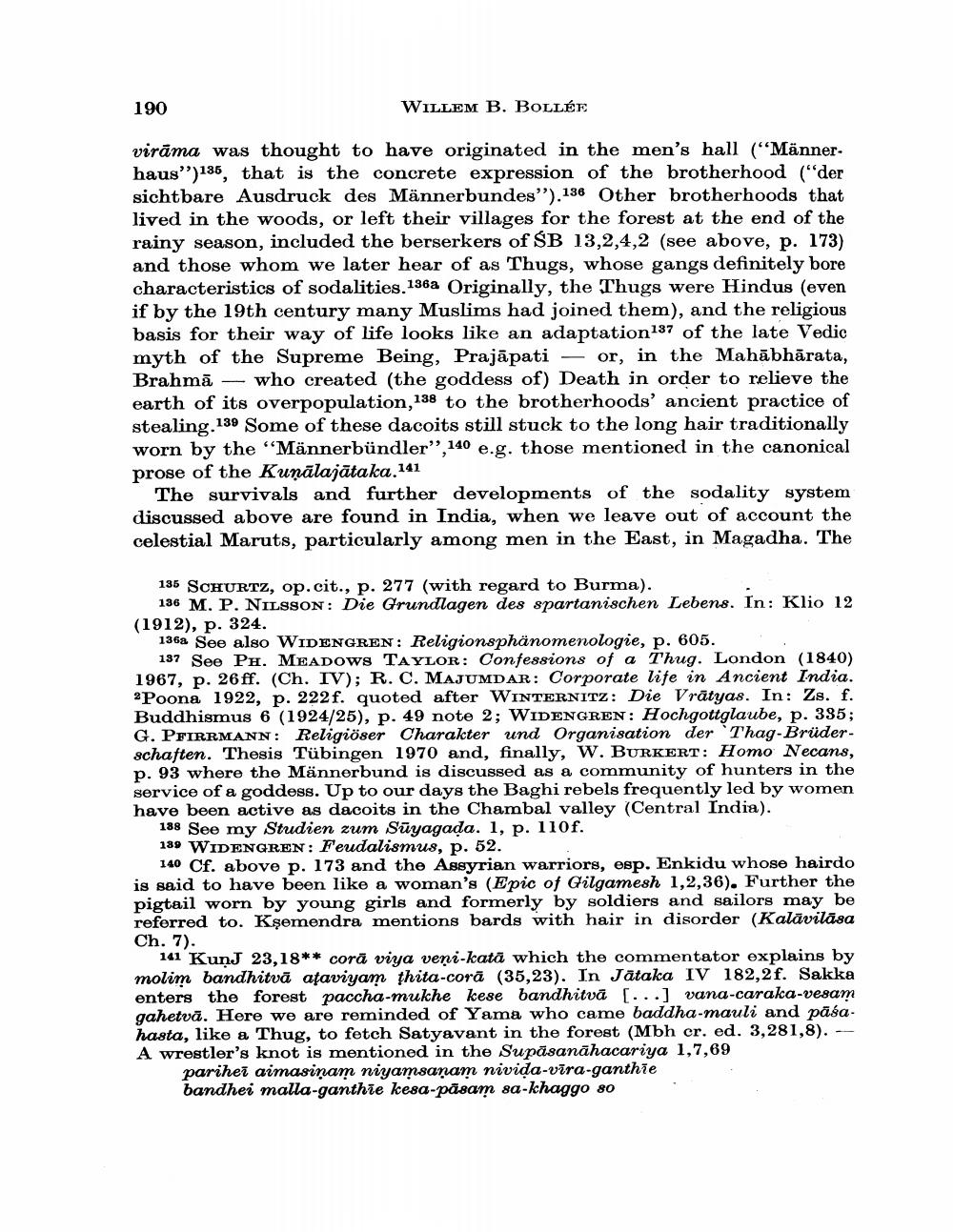________________
190
WILLEM B. BOLLÉE
virāma was thought to have originated in the men's hall ("Männer. haus'')186, that is the concrete expression of the brotherhood ("der sichtbare Ausdruck des Männerbundes").136 Other brotherhoods that lived in the woods, or left their villages for the forest at the end of the rainy season, included the berserkers of SB 13,2,4,2 (see above, p. 173) and those whom we later hear of as Thugs, whose gangs definitely bore characteristics of sodalities. 136a Originally, the Thugs were Hindus (even if by the 19th century many Muslims had joined them), and the religious basis for their way of life looks like an adaptation137 of the late Vedic myth of the Supreme Being, Prajāpati — or, in the Mahābhārata, Brahmā — who created (the goddess of) Death in order to relieve the earth of its overpopulation, 138 to the brotherhoods' ancient practice of stealing 139 Some of these dacoits still stuck to the long hair traditionally worn by the "Männerbündler",140 e.g. those mentioned in the canonical prose of the Kunālajātaka. 141
The survivals and further developments of the sodality system discussed above are found in India, when we leave out of account the celestial Maruts, particularly among men in the East, in Magadha. The
135 SCHURTZ, op.cit., p. 277 (with regard to Burma).
136 M. P. NILSSON: Die Grundlagen des spartanischen Lebens. In: Klio 12 (1912), p. 324.
1368 See also WIDENGREN: Religionsphänomenologie, p. 605.
137 See PH. MEADOWS TAYLOR: Confessions of a Thug. London (1840) 1967, p. 26 ff. (Ch. IV); R. C. MAJUMDAR: Corporate life in Ancient India. 2Poona 1922, p. 222f. quoted after WINTERNITZ: Die Vrätyas. In: Zs. f. Buddhismus 6 (1924/25), p. 49 note 2; WIDENGREN: Hochgottglaube, p. 335; G. PFIRRMANN: Religiöser Charakter und Organisation der 'Thag-Brüderschaften. Thesis Tübingen 1970 and, finally, W. BURKERT: Homo Necans, p. 93 where the Männerbund is discussed as a community of hunters in the service of a goddess. Up to our days the Baghi rebels frequently led by women have been active as dacoits in the Chambal valley (Central India).
188 See my Studien zum Süyagada. 1, p. 110f. 189 WIDENGREN: Feudalismus, p. 52.
140 Cf. above p. 173 and the Assyrian warriors, esp. Enkidu whose hairdo is said to have been like a woman's (Epic of Gilgamesh 1,2,36). Further the pigtail worn by young girls and formerly by soldiers and sailors may be referred to. Kşemendra mentions bards with hair in disorder (Kalāvilāsa Ch. 7).
141 KunJ 23,18** corä viya veni-katā which the commentator explains by molim bandhitvä afaviyam thita-corā (35,23). In Jataka IV 182,2f. Sakka enters the forest paccha-mukhe kese bandhitvä [...] vana-caraka-vesam gahetvā. Here we are reminded of Yama who came baddha-mauli and pāśahasta, like a Thug, to fetch Satyavant in the forest (Mbh cr. ed. 3,281,8). -- A wrestler's knot is mentioned in the Supāsanāhacariya 1,7,69
parihet aimasinam niyamsanam nivida-vīra-ganthie bandhei malla-ganthie kesa-păsam sa-khaggo 80




